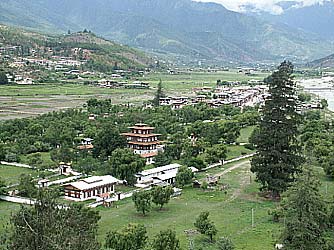|
Bhutan's National Heritage
|

|
 |
Bhutan
Heritage |
|
 |
Bhutan
Heritage |
|
|
|
 |
The
royal government of Bhutan has already been spent more than Nu 22
million in the preparations to renovate the 451-year old Gangtoe Lhakhang,
the most important seat of the Peling tradition of Buddhism in western
Bhutan. The renovation, expected to take about three years. After
the renovation is completed a mithub (fire proof room) will be constructed
on the ground floor to store all the precious nangtens of the goenpa. The
renovation will help preserve a very sacred religious monument, which has
played an important role in the evolution of Bhutanese culture, religious
history and, more specifically, the Peling tradition of Buddhism.
According
to legend, Pema Lingpa visited Phobjikha on his way back from Bumthang.
While conferring blessings for the people in present day Gangtoe he prophesized,
facing the hillock where the Goenpa stands today, that one of his incarnations
would establish a monastery on the hillock for the propagation of the Peling
sect. The mound was named Gangtoe Sanga Choling, meaning the "Mound of
the Sanga sect".
Following the prophecy, Pema Lingpa's first incarnation,
Gyalse Pema Thinley, built a small temple on the mound. The second incarnation,
Tenzin Lekpai Dhendup, built the present monastery in 1613. Containing
many ancient and rare spiritual relics, the ground floor of the monastery
is known for its eight great pillars. It houses the Dukhang (prayer hall)
and the statues of Sangay Rabduen (the Seven Buddhas). The Goenkhang is
located in the middle floor. The top floor contains the Guru Tshengye (the
eight manifestations of Guru Rinpoche) Lhakhang, the Machen Lhakhang, the
Lam Lhakhang and the Tshepagme Lhakhang. At the 12 corners of the monastery
are the images of 80 renowned saints, 25 disciples of Guru Rinpoche, 21
Taras and Neyten Chudru (16 Arhats), all carved on slates. Gangtoe Goemba
has a large collection of Peling lineage thangkas and also one of the most
beautiful and exquisite Neyten Chudru thangkas in the whole of Bhutan.
The Nyungney Lhakhang at the top of the main entrance to the monastery
was built by the eighth Gangtoe Trulku, Thinlay Dorji. The double-story
Utse contains the Purdung Chorten of Tenzin Legpai Dhendup, the second
Gangtoe Trulku.Today, the lhakhang houses a Shedra, a Gomdey and a Drubdey.
Started in 1986 by the present Gangtoe Trulku with the support of the royal
government, the Shedra, known as Dhonga Thoe-sam, offers a nine-year course
in Buddhist studies. The Drubdey was started in 1990 by the 68th Je Khenpo,
His Holiness Tenzin Dhendup, with financial support from the government.
|
Paro
Dzong and Ugyen Pelri Palace in Paro
|
 |
| Ugyen
Pelri Palace in Paro |
Paro
Valley is one of the most populated area in the country. Because of its
proximity to the airport, there are hotels and tourist amenities close
by. The Paro Valley contains a wealth of attractions and requires a few
days to be properly explored. Casting a shadow across the town of Paro
and controlling all secular and religious activities in its valley is the
elegant and perfectly symmetrical Rinpung Dzong. It is a fortress situated
on a knoll across the Paro Chu river with acommanding view of the Paro
valley.
|
|
The Rinpung Dzong built during the 17th century, which is
now used as an administration center and school for monks. Behind Rinpung
Dzong, on the high hillside, is the castle shaped Ta Dzong. Once a watch
tower built to defend Rinpung Dzong during inter-valley wars in the 17th
Century, Ta Dzong has housed the nations heritage in Bhutan's National
Museum since 1967.
 |
| Paro
Dzong and Ta-Dzong Fort in Paro |
The
museum provides an excellent way to pass an afternoon and its circular
shape augments its varied collection. The Ta Dzong Fort which displays
antique thankha paintings, textiles, weapons and a very interesting collection
of postage stamps.
Ugyen
Pelri Palace is in a seculuded wooded compound on the south side of the
Paro Chhu (river). The palace was built by a Paro penlop in the early 1900s. |
|
The palace is now a residence of the Queen's mother. On the roadside besideUgyen Pelri Palace are five square chortens.
|




